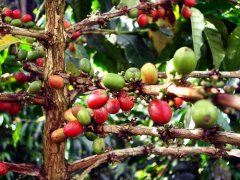Planting coffee trees requires the weather, climate and soil quality of the province.
1. Climatic conditions
Arabica coffee is not resistant to high temperature and humid climate, nor can it stay at a low temperature below 5 ℃ for a long time, so it is planted on steep slopes of 1000 to 2000 meters above sea level. On the other hand, Robusta caffeine is adaptable (Robusta originally means "tenacious and strong") and is mostly grown in lowlands below 1000 meters above sea level.
The average annual rainfall of 1000 mm to 2000 mm, coupled with moderate sunshine, is the most suitable environment for coffee growth. However, Arabica coffee is not resistant to strong sunlight and extreme heat, so it is suitable for growing in terrain prone to morning fog, especially where there is a large temperature difference between day and night. In addition, some places will plant shelter trees in order to avoid direct sunlight, such as bananas, maize, mango trees and so on.
two。 Soil quality
To put it simply, the soil suitable for growing coffee is fertile volcanic soil with enough moisture and moisture, and rich in organic matter. The Ethiopian plateau is covered with this kind of volcanic weathered soil, so the soil rich in humus is naturally one of the basic conditions for growing coffee.
In fact, the main coffee-producing areas in the highlands of Brazil (called "Terra rossa", meaning fertile red soil weathered by basalt), the highlands of Central America, around the Andes of South America, the African highlands, the West Indies, Java (some of the soils are also weathered by volcanic rocks, or a mixture of volcanic ash and humus), and the Ethiopian highlands, have fertile soils with plenty of water.
Soil has a subtle effect on the taste of coffee. For example, the acidity of coffee grown on slightly acidic soil will also be strong; for example, the soil around Rio de Janeiro in Brazil has an iodine flavor, and the coffee will also be contaminated with that unique flavor by shaking the fruit to the ground when picking coffee beans.
3. Topography and height
It is generally believed that the coffee produced in the highlands is of better quality. Coffee-producing countries in Central America will use "elevation" as the grading standard because there are mountains crossing from the center of the continent. For example, SHB (Strictly Hard Bean) in Guatemala, the highest of the seven grades, is called SHB, which represents that its producing area is about 1370 meters above sea level.
Although the coffee farm is located on steep slopes and is not convenient for transportation, transportation, cultivation and management, this terrain has low temperatures and is prone to morning fog, which can ease the strong sunshine peculiar to the tropics and allow time for the coffee fruit to fully mature.
However, high-grade coffee such as "Blue Mountain" and "Hawaiian Kona" on the island of Jamaica are not harvested in the highlands. Because as long as there is the right temperature, rainfall and soil, there will be morning fog and a large temperature difference between day and night, high-quality coffee can be grown. It can be seen that even if "high real estate equals high quality", it does not mean that "low real estate equals low quality". Elevation can only be regarded as one of the reference criteria for judging the grade of coffee. Although elevation is important, the topography and climatic conditions of the producing area are more important.
European countries, the main consumer of coffee, gave high praise to highland coffee such as Kenya and Colombia a long time ago. Quantitative coffee beans can extract more coffee liquid (that is, higher concentration), which is one of the reasons why Highland Coffee is well received.
In addition, as mentioned earlier, the Robusta coffee native to the Congo is grown in the lowlands below 1000 meters above sea level. Unlike Arabica, it grows fast and is resistant to diseases and insect pests. It can also be grown in non-fertile soil, so its taste and aroma are far inferior to Arabica coffee.

Important Notice :
前街咖啡 FrontStreet Coffee has moved to new addredd:
FrontStreet Coffee Address: 315,Donghua East Road,GuangZhou
Tel:020 38364473
- Prev

Introduction to the types, varieties, taste and flavor of coffee beans
Mantenin (Indonesia, Sumatra, Asia) Acid 0 Glycerol 3 Alcohol 3 aroma 3 characteristic Flavor Blue Mountain (Jamaica, Central America, West Indies) Acid 1 Gump 3 bitter Alcohol 3 aroma 3 the highest quality Columbia (Colombia, South America) Acid 2 Glycerol 3 bitter Alcohol 3 aroma 2 most Standard quality Mocha (Isbiya, Africa) Acid 3 Glycine 2 bitter 1 Alcohol 2 aroma 2 characteristic Flavor Clemangaro (Tanzania)
- Next

High-quality Costa Rican coffee is called "extra hard beans".
High-quality Costa Rican coffee is called extra hard beans, and this kind of coffee can grow at an altitude of more than 1500 meters. Altitude has always been a problem for coffee growers. The higher the altitude, the better the coffee beans, not only because the higher altitude can increase the acidity of the coffee beans and thus increase the flavor, but also because the night temperature at the higher altitude is lower, which can make the trees grow slowly.
Related
- Guji coffee producing area of Guji, Ethiopia: Humbela, Shakiso, Wulaga
- What is the most expensive variety of Qiloso in BOP multi-variety group?
- How to store the coffee beans bought home?
- Why are Yemeni coffee beans so rare now?
- Ethiopian Sidamo all Red Fruit Sun Sun Santa Vini Coffee beans
- SOE is mostly sour? What does it mean? Is it a single bean? what's the difference between it and Italian blending?
- Is Italian coffee beans suitable for making hand-brewed coffee?
- How to choose coffee beans when making cold coffee? What kind of coffee beans are suitable for making cold coffee?
- Just entered the pit to make coffee, what kind of coffee beans should be chosen?
- Can only Japan buy real Blue Mountain Coffee? What are authentic Jamaican Blue Mountain coffee beans?

